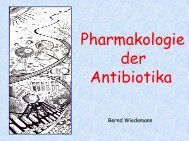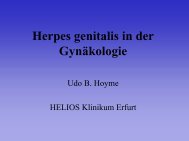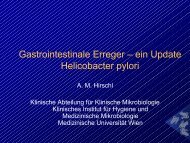Antimykotika in der Zulassung
Antimykotika in der Zulassung
Antimykotika in der Zulassung
Erfolgreiche ePaper selbst erstellen
Machen Sie aus Ihren PDF Publikationen ein blätterbares Flipbook mit unserer einzigartigen Google optimierten e-Paper Software.
<strong>Antimykotika</strong> <strong>in</strong> <strong>der</strong><br />
<strong>Zulassung</strong><br />
Zuständigkeitsbereich des<br />
Bundes<strong>in</strong>stitut für Arzneimittel und<br />
Mediz<strong>in</strong>produkte (BfArM)<br />
- Fachgebiet Anti<strong>in</strong>fektiva -<br />
Frühjahrstagung PEG 12.-13.05.2006
<strong>Antimykotika</strong> <strong>in</strong> <strong>der</strong> <strong>Zulassung</strong><br />
Verfahren <strong>in</strong> <strong>der</strong> <strong>Zulassung</strong>:<br />
• Nationale Verfahren : neue und bekannte Stoffe<br />
• Parallelimportzulassung<br />
• Nachzulassung § 105 AMG<br />
(Nachfolgeverfahren: Än<strong>der</strong>ungen, Verlängerungen,<br />
Wi<strong>der</strong>sprüche/Klagen)<br />
Frühjahrstagung PEG 12.-13.05.2006<br />
2
<strong>Antimykotika</strong> <strong>in</strong> <strong>der</strong> <strong>Zulassung</strong><br />
EU-<strong>Zulassung</strong>en:<br />
• MRP (Richtl<strong>in</strong>ien 75/319/93)<br />
• CP (EWG Nr. 2309/93)<br />
(Nachfolgeverfahren: Variations, Renewals, Arbitration)<br />
Frühjahrstagung PEG 12.-13.05.2006<br />
3
<strong>Antimykotika</strong> <strong>in</strong> <strong>der</strong> <strong>Zulassung</strong><br />
Problem bei MRP:<br />
erteilte <strong>Zulassung</strong> nach E<strong>in</strong>igung <strong>der</strong> MS auf e<strong>in</strong>en ‚kle<strong>in</strong>(st)en‚<br />
kle<strong>in</strong>(st)en‘<br />
geme<strong>in</strong>samen Nenner.<br />
Beispiel: Fluconazol (Abschnitt 4.3 Gegenanzeigen)<br />
• /.../ darf nicht bei e<strong>in</strong>er angeborenen o<strong>der</strong> erworbenen QT-<br />
Verlängerung angewendet werden.<br />
• /.../ darf nicht mit Arzneimitteln, die ebenfalls zu e<strong>in</strong>er Verlängerung<br />
des QT-Intervals führen können, wie z.B. Antiarrhythmika <strong>der</strong> Klasse<br />
IA und III angewendet werden.<br />
Frühjahrstagung PEG 12.-13.05.2006<br />
4
<strong>Antimykotika</strong> <strong>in</strong> <strong>der</strong> <strong>Zulassung</strong><br />
• /.../ darf nicht bei Störungen des Elektrolythaushaltes<br />
und hier beson<strong>der</strong>s bei e<strong>in</strong>er Hypokaliämie und<br />
Hypomagnesiämie angewendet werden.<br />
• /.../ darf nicht bei e<strong>in</strong>er kl<strong>in</strong>isch relevanten Bradykardie<br />
und bei Herzrhythmusstörungen (z.B. bei schwerer<br />
Herz<strong>in</strong>suffizienz) angewendet werden.<br />
Nach Arbitrationverfahren: als relative Gegenanzeige<br />
<strong>in</strong> Abschnitt 4.4 <strong>der</strong> SPC<br />
Frühjahrstagung PEG 12.-13.05.2006<br />
5
<strong>Antimykotika</strong> <strong>in</strong> <strong>der</strong> <strong>Zulassung</strong><br />
‚zugelassene‘ <strong>Antimykotika</strong> <strong>in</strong> DE (Stand 10.5.2006)<br />
Wirkstoffgruppe/<br />
Applika-<br />
Gesamt- V A<br />
Wirkstoff<br />
tionsart<br />
Anzahl<br />
___________________________________________________________________________<br />
Polyene (syst./top.)<br />
Amphoteric<strong>in</strong> B<br />
i.v.; .; oral; top. 8 8 -<br />
Nystat<strong>in</strong><br />
oral, top. 71 13 58<br />
Natamyc<strong>in</strong><br />
top. 5 4 1<br />
Ech<strong>in</strong>ocand<strong>in</strong>e (syst.)<br />
Caspofung<strong>in</strong><br />
Sonstige (syst.)<br />
Flucytos<strong>in</strong><br />
Griseofulv<strong>in</strong><br />
Terb<strong>in</strong>af<strong>in</strong><br />
i.v. 3 3 -<br />
i.v. 1 1 -<br />
oral 4 4 -<br />
oral 58 58 -<br />
Sonstige (top.)<br />
Amorolf<strong>in</strong><br />
top. 4 - 4<br />
Ciclopirox 26 21 5<br />
Tolnaftat 8 - 8<br />
Naftif<strong>in</strong> 3 - 3<br />
Terb<strong>in</strong>af<strong>in</strong> 10 - 10<br />
Frühjahrstagung PEG 12.-13.05.2006<br />
6
<strong>Antimykotika</strong> <strong>in</strong> <strong>der</strong> <strong>Zulassung</strong><br />
‚zugelassene‘ <strong>Antimykotika</strong> <strong>in</strong> DE (Stand 10.5.2006)<br />
Imid-/Tri-)-<br />
Azole -(syst.)<br />
Fluconazol<br />
i.v., ., oral 164 164 -<br />
Itraconazol “ 54 54 -<br />
Voriconazol “ 49 49 -<br />
Posaconazol<br />
oral 2 2 -<br />
Ketoconazol<br />
oral, top. 19 9 10<br />
- top.<br />
Bifonazol<br />
top. 18 18 -<br />
Clotrimazol 200 72 135<br />
Croconazol 4 - 4<br />
Econazol 18 9 9<br />
Fenticonazol 4 - 4<br />
Frühjahrstagung PEG 12.-13.05.2006<br />
7
<strong>Antimykotika</strong> <strong>in</strong> <strong>der</strong> <strong>Zulassung</strong><br />
‚zugelassene‘ <strong>Antimykotika</strong> <strong>in</strong> DE (Stand 10.5.2006)<br />
Isoconazol<br />
top. 10 10 -<br />
Miconazol 53 32 22<br />
Oxiconazol 8 2 6<br />
Sertaconazol 4 - 4<br />
Tioconazol 4 - 4<br />
_____________________________________________________________________________<br />
• Azole 611 (278(<br />
syst.; 333 top.)<br />
• Sonstige 201<br />
Frühjahrstagung PEG 12.-13.05.2006<br />
8
<strong>Antimykotika</strong> <strong>in</strong> <strong>der</strong> <strong>Zulassung</strong><br />
Problem:<br />
• Möglichkeit <strong>der</strong> Resistenzentwicklung gegen Azol-<br />
<strong>Antimykotika</strong> durch e<strong>in</strong>e unkontrollierte Behandlung<br />
(Abgabe von apothekenpflichtigen Produkten)<br />
Beispiel:<br />
The Commission <strong>in</strong>tended to propose to allow the use of<br />
ketoconazole <strong>in</strong> cosmetic products, limited to a concentration<br />
of 2% based on a scientific op<strong>in</strong>ion of the Scientific Committee<br />
on Cosmetic Products and Non-Food Products <strong>in</strong>tended for<br />
Consumers (SCCNFP).<br />
Frühjahrstagung PEG 12.-13.05.2006<br />
9
<strong>Antimykotika</strong> <strong>in</strong> <strong>der</strong> <strong>Zulassung</strong><br />
Estimation on the patient exposure with ketoconazole conta<strong>in</strong><strong>in</strong>g products/country /year*<br />
Country<br />
Systemic Products<br />
Topical products<br />
Austria n. d. n. d.<br />
Belgium 2002: 40,679 pck. . Tablets 2002: 498,075 pck. . cream/<br />
shampoo<br />
2003: 19,150 pck. . Tablets 2003: 395,399 pck. . cream/<br />
shampoo<br />
France 2003: 190,205 pck. . Tablets 2003: 5,478,497 pck. . cream tubes/<br />
sachets<br />
Frühjahrstagung PEG 12.-13.05.2006<br />
10
<strong>Antimykotika</strong> <strong>in</strong> <strong>der</strong> <strong>Zulassung</strong><br />
Estimation on the patient exposure with ketoconazole conta<strong>in</strong><strong>in</strong>g products/country /year*<br />
Country<br />
Systemic Products<br />
Topical products<br />
Germany 2002: 23,022 pck. Tablets 2002: 1,500,600 pck. cream/shampoo<br />
/ liquid<br />
2003: 20,359 pck. Tablets 2003: 1,216,700 pck. “<br />
Sweden<br />
UK<br />
2001: 71,000 DDD 2001: 26 million<br />
2002: 80,000 DDD 2002:25 million DDD<br />
2003: 77,000 DDD 2003 24 million DDD<br />
2003: 7,100 prescriptions >540,000 prescriptions<br />
___<br />
* some examples<br />
Frühjahrstagung PEG 12.-13.05.2006<br />
11
<strong>Antimykotika</strong> <strong>in</strong> <strong>der</strong> <strong>Zulassung</strong><br />
• Verschreibungsstatus <strong>in</strong> den EU-Län<strong>der</strong>n<br />
verschieden<br />
POM<br />
Austria: Cream 2%<br />
F<strong>in</strong>land<br />
Iceland<br />
Spa<strong>in</strong> + NL<br />
OTC<br />
Shampoo
<strong>Antimykotika</strong> <strong>in</strong> <strong>der</strong> <strong>Zulassung</strong><br />
Ergebnis:<br />
Datenlage bisher unzureichend<br />
Verschreibungspflicht für alle <strong>Antimykotika</strong>!<br />
Frühjahrstagung PEG 12.-13.05.2006<br />
13
<strong>Antimykotika</strong> <strong>in</strong> <strong>der</strong> <strong>Zulassung</strong><br />
• Annex II <strong>der</strong> EU Cosmetic Directive:<br />
Antibiotika nicht erlaubt als Bestandteil von<br />
Kosmetika<br />
• Def<strong>in</strong>ition von Antibiotika gemäß<br />
‚Regulation (EC) No 1831/3003 of the<br />
European Parliament<br />
Council of 22.9.2003 on additives for use <strong>in</strong><br />
animal nutrition<br />
Frühjahrstagung PEG 12.-13.05.2006<br />
14
<strong>Antimykotika</strong> <strong>in</strong> <strong>der</strong> <strong>Zulassung</strong><br />
1. „antimicrobial agents“ “ means substances<br />
produced either synthetically or naturally<br />
by bacteria, fungi or plants, used to kill or<br />
<strong>in</strong>hibit growth of micro-organisms<br />
organisms<br />
<strong>in</strong>clud<strong>in</strong>g bacteria, viruses and fungi, and<br />
of parasites, <strong>in</strong> particular<br />
protozoa<br />
Frühjahrstagung PEG 12.-13.05.2006<br />
15
<strong>Antimykotika</strong> <strong>in</strong> <strong>der</strong> <strong>Zulassung</strong><br />
2. „antibiotic“ means antimicrobial produced by<br />
or <strong>der</strong>ived from a micro-organism, organism, which<br />
destroys or <strong>in</strong>hibits the growth of other micro-<br />
organisms.<br />
Antibiotics means Antimicrobial and<br />
Antimicrobial agents means substances …..kill<br />
or <strong>in</strong>hibit … fungi<br />
Frühjahrstagung PEG 12.-13.05.2006<br />
16
<strong>Antimykotika</strong> <strong>in</strong> <strong>der</strong> <strong>Zulassung</strong><br />
Antifungal agent = antibiotic agent<br />
Frühjahrstagung PEG 12.-13.05.2006<br />
17
<strong>Antimykotika</strong> <strong>in</strong> <strong>der</strong> <strong>Zulassung</strong><br />
Targetpopulation<br />
• Komplexität <strong>der</strong> Patientenpopulation<br />
Patienten mit Knochenmark- und<br />
Organtransplantation, malignen, hämatologischen<br />
Erkrankungen, Krebs und AIDS<br />
Schweregrad <strong>der</strong> Grun<strong>der</strong>krankung<br />
Begleitmedikation (Dauer)<br />
Behandlungsdauer mit versch. <strong>Antimykotika</strong><br />
Komb<strong>in</strong>ationstherapie<br />
Anzahl Patienten<br />
Frühjahrstagung PEG 12.-13.05.2006<br />
18
<strong>Antimykotika</strong> <strong>in</strong> <strong>der</strong> <strong>Zulassung</strong><br />
Targetpopulation<br />
statistisch abgesicherte Auswertung schwierig<br />
Beschreibung <strong>der</strong> Kl<strong>in</strong>ischen Erfahrung im<br />
Abschnitt 5.1 <strong>der</strong> SPC<br />
Frühjahrstagung PEG 12.-13.05.2006<br />
19
<strong>Antimykotika</strong> <strong>in</strong> <strong>der</strong> <strong>Zulassung</strong><br />
spezielle Patientengruppen<br />
• Säugl<strong>in</strong>ge, K<strong>in</strong><strong>der</strong>, Jugendliche<br />
ke<strong>in</strong>e o<strong>der</strong> e<strong>in</strong>geschränkte Daten<br />
Formulierung <strong>in</strong> <strong>der</strong> SPC z.B.<br />
- Wirksamkeit und Unbedenklichkeit<br />
nicht untersucht<br />
- begrenzte Daten (s.(<br />
5.2 Studienbeschreibung<br />
wird nicht empfohlen<br />
s. 5.2 Studienbeschreibung)<br />
Frühjahrstagung PEG 12.-13.05.2006<br />
20
<strong>Antimykotika</strong> <strong>in</strong> <strong>der</strong> <strong>Zulassung</strong><br />
spezielle Patientengruppen<br />
• Daten vom sog. ‚established use‘ von<br />
Arzneimitteln<br />
• Beispiel: FLUCONAZOL<br />
bisher: Aufgrund ger<strong>in</strong>ger Erfahrungen sollte<br />
/.../ bei K<strong>in</strong><strong>der</strong>n unter 16 Jahren nur angewen-<br />
det werden, wenn ke<strong>in</strong>e therapeutische Alter-<br />
native zur Verfügung steht.<br />
Frühjahrstagung PEG 12.-13.05.2006<br />
21
<strong>Antimykotika</strong> <strong>in</strong> <strong>der</strong> <strong>Zulassung</strong><br />
spezielle Patientengruppen<br />
• Neues Verfahren (außerhalb <strong>der</strong> offiziellen<br />
Verfahren) zur <strong>Zulassung</strong><br />
EU workshar<strong>in</strong>g projects <strong>in</strong> the assessment of<br />
paediatric data (MRFG)<br />
Start dieser Verfahren mit ausgewählten AM<br />
2005<br />
Dauer: 180 Tage + anschl. Variation-Verfahren<br />
Verfahren<br />
Frühjahrstagung PEG 12.-13.05.2006<br />
22
<strong>Antimykotika</strong> <strong>in</strong> <strong>der</strong> <strong>Zulassung</strong><br />
spezielle Patientengruppen<br />
• Patienten mit Leber- und Nierenschäden<br />
• Patienten mit seltenen Infektionen<br />
(Scedosporium- und Fusarium-Infektionen)<br />
Frühjahrstagung PEG 12.-13.05.2006<br />
23
<strong>Antimykotika</strong> <strong>in</strong> <strong>der</strong> <strong>Zulassung</strong><br />
Empfehlungen/Richtl<strong>in</strong>ien<br />
• CPMP/EWP/1343/03<br />
Po<strong>in</strong>ts to Consi<strong>der</strong> on the evaluation of<br />
New Antifungal Agents for Invasive<br />
Fungal Infections<br />
• Several CPMP + ICH guidel<strong>in</strong>es (see(<br />
above<br />
mentioned ‘Po<strong>in</strong>ts to Consi<strong>der</strong>…’)<br />
Frühjahrstagung PEG 12.-13.05.2006<br />
24



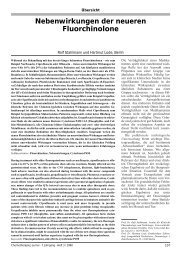
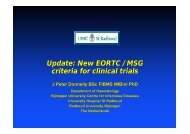
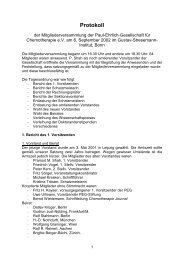
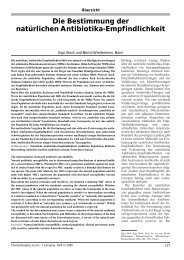

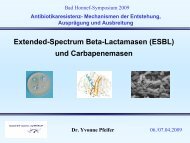
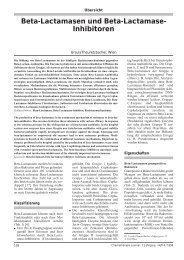
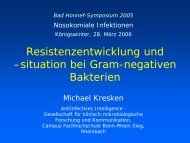

![Willinger.ppt [Schreibgeschützt]](https://img.yumpu.com/25098535/1/190x135/willingerppt-schreibgescha-1-4-tzt.jpg?quality=85)
